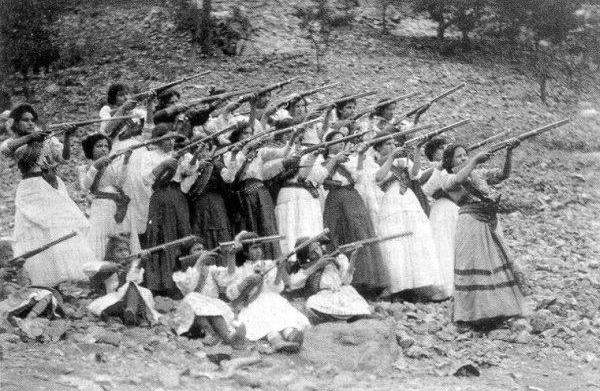Winner of the Spring 2018 StMU History Media Award for
Best Article in the Category of “Gender Studies”
“La Adelita” was one of the most popular corridos, or songs of romance, during the Mexican Revolution (1910-1920).1 This song is the love story of a young woman who travels with a sergeant and his regiment during the revolution.2 The song praises Adelita, the sweetheart of the troop, for both her beauty and her valor, noting how she is wanted by the other soldiers. We can imagine this woman as an object of desire, whose beauty and physique attracted the soldiers, and eventually broke their hearts. But this description is actually… incorrect.3
The Adelita, also known as soldadera, or female soldier, is the term used to describe women who contributed to many aspects of the Mexican Revolution. These women worked as nurses, food providers, lovers, spies, messengers, and fighters.4 In fact, some reached the rank of colonel and general. Many of them were forced by their husbands to follow them and work in the camps, but there were also those who volunteered to join the cause.5 Today, soldaderas are remembered as strong and courageous women who took up weapons and became fighters, often having to cut their hair and dress to appear like their male counterparts, because of the oppressive gender inequality prevalent in the Mexican society of that time.6 There is one soldadera in particular, Petra Herrera, also known as La Guerrera, and as La Generala (female general), who joined the cause and fought with the strongest of the soldiers. But what inspired women to join their male counterparts to fight this war, and why did the revolution even happen?

To answer this question and to be able to understand why these women now make up a very important aspect of Mexico’s history and its formation as a country, we need to go back in time to 1876, when the general and politician Porfirio Díaz became president. Porfirio Díaz was known to be a corrupt, elitist president, who favored wealthy landowners, industrialists, and foreign interests.7 The country was also known for the slave-like conditions rural people faced while working on the haciendas owned by wealthy landowners.8 These rural workers were very dissatisfied with the lack of voice they had in the government. But the precipitating event that sparked the revolution was Díaz’s announcement, in 1908, that he would run for his seventh term as president in 1910. This caused controversy among the people who had been suffering from his long regime. Francisco I. Madero then rose as the leader of the Antireeleccionistas (Anti-Reelection alliance). Madero subsequently announced that he would be running for president against Díaz. This prompted the mobilization of armies throughout Mexico. Countless leaders, such as Pascual Orozco and Pancho Villa, began raiding government garrisons as part of an uprising to remove the current president and eventually, elect a new president for the country.9 These were some of the events that inspired and sparked the courage of not only men but of women as well, to join the armies and fight for the shared goal of overthrowing Díaz’ dictatorship and make democracy in Mexico a reality.10

Petra Herrera witnessed the suffering of her country and decided to take action. She witnessed the harshness of landowners and the terrible conditions in which workers lived. She knew that the government had to change from being a corrupt one to being a democratic and fair one. But how would she help? Women at that time faced strict social prohibitions that kept them from playing important roles in the workforce. Instead, they were expected to be caregivers, stay at home, and take care of their children. Women were seen as precious and delicate, something that could not blend with the harshness of war. Petra, instead of following that norm, disguised herself as a man and started calling herself “Pedro Herrera” in order to join the revolutionary troops of Pancho Villa.11
During her time in the camp, she had to lie to her fellow soldiers in order to protect her identity. For example, she would lie that she shaved at dawn before the other soldiers woke up.12 Because of this, “Pedro” was able to blend in perfectly. Quickly after her joining the army, Petra was recognized as an aggressive fighter who carried out military operations efficiently and strategically. In disguise, she came to be known as a courageous and brave soldier, and was soon praised for her intelligence and her skills at blowing up bridges.

Thanks to the acknowledgment she faced on behalf of her peers and her establishment as a strong soldier, Petra decided she would confess her true identity. She believed this would not affect her position or status in the militia, and that she would be accepted and even promoted to general. But sadly, when she told the truth, she was removed from the army instead.13 Consequently, she decided to organize a group of women who were likewise removed from combat, even after they had fought courageously for the same cause as their male counterparts. Petra decided not to give up, and she organized a group of more than four hundred women with the same motive: to put an end to the current presidency and the hardships that Díaz had imposed on the citizens. Her militia not only fought in several battles, but Petra united these fighting women with Pancho Villas’ forces, despite his denial of them fighting and bearing arms. Together, they were able to take the city of Torreón on May 30, 1914, which had been a military base for Díaz’s central federation.14 At the end of the fight, she requested General Castro, a leader of the revolution, to allow her to re-enter the military and make her general, but he only granted her the title of colonel and disbanded her woman’s brigade.15 But her work did not end there. After the demobilization of the woman’s militia, Petra decided to join Venustiano Carranza, one of the main political leaders of the revolution who later became president of Mexico. She became a spy for him and worked as a bartender in Jimenez, a city in the northern part of Mexico.16 But while she was working there, she was shot three times by a group of drunk men, later dying from the injuries.
Despite the effort and the work Petra Herrera gave for the revolution, she has barely received any acknowledgment as a soldadera. There are several causes for this. Men during those times had mixed feelings about women being in combat and the role they had in the fight.17 One of the most passionate opponents of women joining the militia and bearing arms was Pancho Villa. He viewed women as liabilities to an army’s offensive strategy and combative potential, even though Petra Herrera and other great female combatants fought at his side several times to free the country from the oppressive presidency.18 There was also the idea that soldaderas were just images of romance during the Mexican Revolution, such as the song of “The Adelita,” contributing to recognizing only a few of them as strong fighters and contributions to this era.19 These women should be acknowledged and we should grant them a higher praise because many were forced to take this role of soldaderas after being abducted and often raped by revolutionaries who invaded their towns and cities. At the end of the day, the labor and effort of women such as Petra were very important factors for what we have come to know as the Mexican Revolution.
Hear the ballad of La Adelita
La Adelita
Spanish20
Little Adela
English translation21
- Beatriz de León, “La Adelita: El Rostro de La Soldadera,” in Reforma (Mexico D.F., Mexico), 2010. ↵
- Beatriz de León, “La Adelita: El Rostro de La Soldadera,” Reforma (Mexico D.F., Mexico), 2010. ↵
- Andrés Reséndez Fuentes, “Battleground Women: Soldaderas and Female Soldiers in the Mexican Revolution,” The Americas, no. 4, (1995): 55-57. ↵
- Oxford Research Encyclopedias, May 9, 2016, s.v. “Working Women in the Mexican Revolution,” by Susie S. Porter. ↵
- Donna Seaman, “Las Soldaderas: Women of the Mexican Revolution,” Booklist 103, no. 12, (2007): 18. ↵
- Elizabeth Salas, Soldaderas in the Mexican Military: Myth and History (Austin, Tex.: University of Texas Press, 1990), 48-49. ↵
- Encyclopedia Britannica, October 25, 2017, s.v. “Mexico | History, Geography, Facts, & Points of Interest – The Mexican Revolution and Its Aftermath.” ↵
- Encyclopedia Britannica, January 2, 2018, s.v. “Mexican Revolution | Causes, Summary, & Facts.” ↵
- Encyclopedia Britannica, January 2, 2018, s.v. “Mexican Revolution | Causes, Summary, & Facts.” ↵
- Encyclopedia of Latin American History and Culture, January 2008 v.s. “Women,” by Francesca Miller and Meredith Glueck. ↵
- Delia Fernandez, “‘La Adelita’ Becomes an Archetype of the Mexican Revolution,” McNair Scholar Journal, Vol. 13, (2009): 57-58. ↵
- Jason Porath, Rejected Princesses: Tales of History’s Boldest Heroines, Hellions, and Heretics, (New York, NY.: Patreon, 2016), 123-124. ↵
- Elena Poniatowska, Las soldaderas: women of the Mexican revolution (El Paso: Cinco Punto Press, 2006), 45. ↵
- Encyclopedia Britannica, October 25, 2017, s.v. “Mexico | History, Geography, Facts, & Points of Interest – The Mexican Revolution and Its Aftermath.” ↵
- Jason Porath, Rejected Princesses: Tales of History’s Boldest Heroines, Hellions, and Heretics, (New York, NY.: Patreon, 2016), 123-124. ↵
- Jason Porath, Rejected Princesses: Tales of History’s Boldest Heroines, Hellions, and Heretics, (New York, NY.: Patreon, 2016), 123-124. ↵
- Wilma Mankiller, Marysa Navarro, and Gloria Steinem, “Feminism and Feminisms: Feminism,” in Reader’s Companion to U.S. Women’s History (Boston, 1998), 187. ↵
- Oxford Research Encyclopedias, May 9, 2016, s.v. “Working Women in the Mexican Revolution,” by Susie S. Porter. ↵
- Alicia Arrizón, “Soldaderas and the Staging of the Mexican Revolution,” TDR: The Drama Review 42, no. 1, (1998): 105–107. ↵
- Amparo Ochoa, “La Adelita,” Corridos Y Canciones de la Revolucion Mexicana, Ediciones Pentagrama, 1995. Featured in video “La Adelita – Amparo Ochoa,” Courtesy of Youtube (https://www.youtube.com/watch?time_continue=64&v=hlGtOv-QEQQ ). ↵
- “La Adelita,” Mexican Folk Song, translation of last three stanzas by phantasmagoria ↵




127 comments
Aneesa Zubair
Growing up in a Mexican family, I remember hearing about the Adelitas since I was very little. Your article helped me understand who they really were and what they did during the Mexican Revolution. The story of Petra Herrera is particularly fascinating. She dressed as a man, fooled the whole army, and then went on to organize a militia that consisted of women. She was a very determined woman, and I wish she was more recognized as an historical figure.
Mariah Cavanaugh
Never underestimate a determined woman! Thank you for introducing us to Petra Herrera and telling her story as well as the stories of the women who fought alongside her. There is never a shortage of stories when it comes to men such as Pancho Villa, but we need to change the narrative and build up the women who came before us and fought with everything they had.
Sofia Andrade
While reading this article I was slightly annoyed at the fact that in the midst of the war women were seen and treated differently although both men and women had a common goal to meet. Men allowed gender differences to get in the way of their country having a better President. Petra and other women warriors helped meet the goal of a better country, however they were not recognized for it.
Jorge Martinez
During my senior year of high school, my directors decided to perform “Las Soldaderas” by Nelly E. Cuellar-Garcia for our theatre competition. It was about a fictionalized version of the soldaderas. I would be assistant director in this production and after months of hard work, we had one amazing show. The show began and ended with the cast singing “La Adelita”, and just thinking about it makes me tear up in joy. Thank you for such an amazing piece and I truly believe that these brave women should be better known.
Engelbert Madrid
This article highlights how women, such as Petra Herrera, did not care about gender norms during the Mexican Revolution. Men thought that the role of a woman was to be caregivers and to stay at home to nurse her children. However, the rise of the Mexican Revolution made women feel that they should do something about it as well. Petra Herrera disguised herself as a man, because she wanted to help the poor class and to defeat the corrupted government in Mexico. Petra Herrera’s story is heroic, a symbol and a representation that women should be treated equally and justly because we all have great potential and abilities as humans.
Michael Thomas
I found this article interesting because of how it details the lives of female soldiers in the Mexican Army during the Mexican Revolution and the life of Petra Herrera. I did not know women played a major role in the Mexican Revolution. Petra Herrera tried to fight in the Mexican militia, but was rejected because she was a women. She tried to prove herself to the militia by fighting with a group of women. It was disappointing that she was still disregarded as a soldier because she was a woman. Overall, this article was informative, good, and well-written.
Esperanza Mauricio
This is a beautiful and informational story about the war efforts that these women faced during the revolution. Their story, although tragic, stands as a strong reminder of the oppression that women had to endure those many years ago. It would be great if the efforts of these women was told in the educational system, so that we may have another example of the strong women who existed abroad; these women who faced the same issues that we were dealing with domestically. I am also brought to tears because of how identical their story is to the infamous Disney movie, Mulan. Mulan might not have the historical backing to prove the story’s plot line, but Petra and the Adelitas’ story stands as a factual backing of the great power that women / the oppressed can withhold.
Belia Camarena
This article is a great read! It is really interesting, and since I had never heard of Petra Hernandez, it was also very informative. It is amazing that Petra knew exactly what she wanted, and she used all methods to achieve her goals. She did not let her gender determine what she could or could not do. She is an inspiration, and she deserves to receive more recognition.
Carlos Vazquez
When studying the Mexican revolution, the contribution of women is often overlooked. I had never heard of Petra Herrera and the famous Adelitas song. I really liked the way you included the video with the lyrics in both Spanish and English because it made the story more interesting. Overall this article was really well written and informative and I really enjoyed reading it and learning more about Petra Herrera.
Anais Del Rio
I hardly read anything regarding my culture, but after reading this article it made me want to read more. These women are one of the stepping stones towards equal rights even if there was none back then. They decided that their community and country needed help and they could provide that. Mexican women really are one of the strongest people there is as proven by these historical ladies and even our own family.